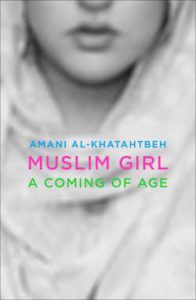
On 9/11, Amani Al-Khatahtbeh—the founder of Muslim Girl, an influential media outlet by and for young Muslim women—was nine years old and living in New Jersey. When she is sent home early from school, her father warns the family, “they’re going to blame us. And it’s going to get much worse.” Soon after, at the flea market where her father owns an electronic store, Al-Khatahtbeh watches as “the Jewelry Lady” from across the aisle hurls insults at her father, gleefully waving a petition demanding the eviction of Muslim vendors and businesses.
“The truth is,” Al-Khatahtbeh writes, “that 9/11 never ended for us.” More than any other generation, she explains, Muslim millenials have been defined by 9/11, their identities indelibly shaped by the Islamophobia that followed.
Every step we take in our non-Muslim home countries, in spite of pressure, threats, judgments, and even laws, is a reluctant act of defiance.
Due to bullying, Islamophobia, and a general lack of self-worth (which many female readers will find all-too relatable), Al-Khatahtbeh grows up with intense feelings of shame and inadequacy. When she is thirteen, her father, concerned about Islamophobia’s increasing virulence, decides to move the family back to Jordan. Here, she bonds with her cousins and is exposed to “Muslim and Arab people’s narratives and diverse stories in their own voices.” She is inspired her to reclaim her identity. When she learns about the historic Battle of Mu’tah, in which the Muslims lose but behave heroically, she decides to start wearing hijab.
Listening to my tutor tell me the story, I was overwhelmed with such pride in my history that I decided in that moment to wear a headscarf, as a public marker that I belonged to these people. I wanted it to be so that before people even knew my name, the first thing they would know is that I am a Muslim.
When Al-Khatahtbeh discusses why she chose to wear hijab, she does not employ the rhetoric of divine commandment or female modesty. For her, it is a decision based on pride in her religious and cultural identity.
You will often hear women wearing hijab expressing their wish that people would get over it, that it is simply a piece of cloth. But as Al-Khatahtbeh explains, particularly in non-Muslim countries, this piece of cloth has become “the flag of Islam,” a flag that symbolizes a multitude of things, from villainy to virtue, to a multitude of people. For the author, it symbolizes her outward act of rebellion, a proverbial fuck you to Islamophobia, an “empowering rejection of the male gaze, colonialism, and anti-Muslim sentiment.” It’s a lot of weight for a simple piece of cloth.
In the second half of the book, the author details her journey from high school blogger to a #woke media entrepreneur and sought-after voice for young Muslim women who debates Alan Dershowitz on CNN and speaks on a panel taking down Bill Clinton. While it’s a challenge to chart one’s own meteoric rise to fame without sounding self-absorbed, Al-Khatahtbeh openly acknowledges both her privilege and the fact that her lighter skin makes her more palatable to the public. She speaks candidly of her acquiescence in being tokenized by the media, even going as far as to wear blue/green colored contacts to seem less obviously Arab, and ticking the mainstream media’s boxes for what is desirable in a young female Muslim leader. Headscarf? Check. Fashion-forward Western attire? Check. Not too dark? Check. Exotic but not too exotic? Check. “Sometimes,” the author explains, “you have to play the game to change the game.”
While much of Al-Khatahtbeh’s impassioned discussions of racism and Islamophobia will be eye opening to non-Muslim readers, the personal aspects of the story may hold the most interest for Muslim readers. Though often portrayed as homogenous, Muslims comprise an extraordinarily diverse community; as someone with roots in South Asia, my favorite chapter was the one set in Amman, Jordan. It is the most narratively compelling part of the book, with complex characters and intimate depictions of life in a vibrant Arab city. Much of the book’s remaining narrative, however, is disjointed, moving haphazardly between argument and anecdote. In the latter half it shifts into a polemic against Islamophobia and a compendium of the author’s success.
If there is a narrative thread, it’s Islamophobia. Al-Khatahtbeh often speaks of the necessity for Muslim women to reclaim their narrative. Because Muslim women are treated as a monolith, “the intricacies of the different identities that exist among Muslim women far beyond their faith are melted away.” Her own memoir is a testament to this: its narrative, like the Muslim millennial generation, is defined almost entirely by Islamophobia. It is reactive rather than introspective, a position that reflects the author’s life, in which Islamophobia forces her to be on never-ending defense, acutely aware of her public image, existing in a “perpetual state of constant awareness and consciousness of the outward eye.”
The book feels less like a conventional memoir and more like a Muslim Girl manifesto, a slim volume that successfully educates readers on the insidiousness of Islamophobia while furthering the media-savvy author’s brand. You leave it with little doubt that Al-Khatahtbeh is the epitome of #Muslimgirlfire—determined, successful, intelligent. In the coming Trump presidency we will be glad to have strong, outspoken young women like her in the frontlines. After all, who better to take down a Twitter-happy president than those who are #fierce, with a book to prove it?




